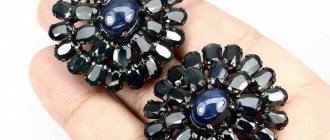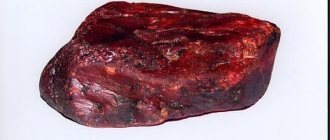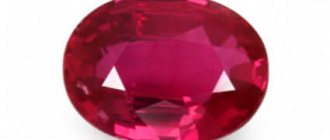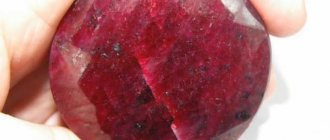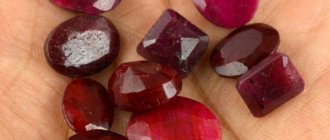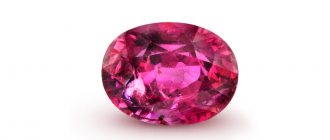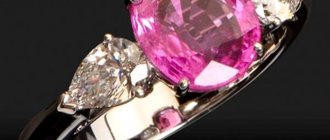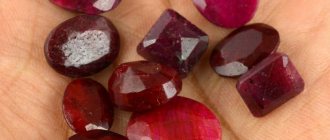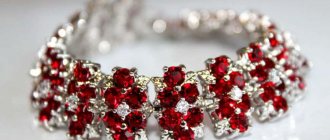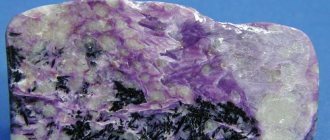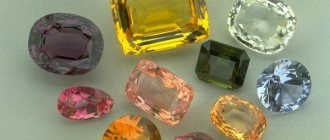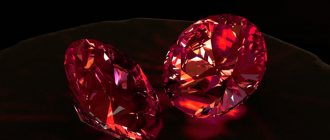People knew about ruby long before the beginning of our era, and even then this stone was valued above other minerals. A hard, luxurious, energetically strong gem became the adornment of noble persons, monarchs, and rulers of this world. Today, some types of ruby are valued more than diamonds, and only diamond occupies the highest level of hardness.
History and origin
People learned about ruby 300–400 BC. In the East, scarlet crystals were revered as the blood of the Dragon.
Ruby
For Ancient Rome it was the number one stone.
- The red ruby is the first of 12 gems on the robe of the high priest of Ancient Judea. King Solomon owned the ring with the star gem.
- Aesculapians of the Middle Ages treated the plague with ruby; alchemists were as eager to obtain it as the philosopher’s stone.
- Two stones (47 and 37 carats) sold by the Burmese king financially ensured his reign and prosperity for several generations.
Ruby means “red” in Latin. Other names for the stone: lal, carbuncle, yakhont. Used as synonyms for the official name.
Interesting Facts
Large, high quality rubies are being discovered less and less often. Moreover, on May 13, 2015, a “blue blood” gem weighing 25.59 carats was sold at the Salisbury auction for a record $30 million.
The largest ruby that has been mined weighs more than 7 years. He was listed in the Guinness Book of Records. Ruby is the most frequently mentioned gem in the Bible.
In ancient times and the Middle Ages, many types of red stones were considered rubies. The large “Black Prince” crystal, which adorns the British crown and was considered a ruby, turned out to be a spinel.
Physicochemical characteristics
Ruby is a variety of corundum and is a top-tier gemstone.
Ruby
Second only to diamond in hardness, the color of ruby is always red. Natural stone with any shade has uneven or zonal coloring.
The length of the pristine gem reaches 2 cm.
| Formula | Al2O3 |
| Color | Red, red-brown, red-purple, red-pink |
| Shine | Glass |
| Transparency | Transparent |
| Hardness | 9 |
| Cleavage | Imperfect |
| Kink | Conchoidal |
| Density | 3.99—4.10 g/cm³ |
Place of extraction
Ruby is found throughout the world, but is often opaque. Corundums are found in mountains (primary or primary deposits) or rivers (placer deposits).
Ruby
The richest and oldest deposits are in Burma and Sri Lanka (Ceylon).
Each deposit has its own color of stone:
- Burma (Myanmar) - red;
- Ceylon - pale colored, purple and star-shaped;
- Madagascar - especially transparent and clean;
- Tanzania - raspberry transparent, glowing after cutting;
- Thailand - dark red and brown;
- Vietnam - purple;
- Indian Kashmir - scarlet.
Sometimes the description of gems from the same mine differs. In the mines of Kashmir, mining is carried out 90 days a year.
The best rubies - deep, rich colors - are mined in Burma (Mogok region). Price range: $25–$5,500 per 1 carat.
In Russia, rubies are found in the Northern Urals and the Kola Peninsula, but there are no separate mines. The gem is mined along the way.
Place of Birth
The mineral is found everywhere. The only continent where it does not exist is Antarctica. Most often, mined rubies are not transparent.
The most valuable, “pure” specimens are found in Burma, as well as Thailand, the islands of Madagascar and Sri Lanka. Ruby suppliers also include:
- Tanzania.
- Kenya.
- India.
- Vietnam.
There is no separate mining of ruby in Russia, but occasionally the mineral is found along with other deposits in the Urals, the Kola Peninsula and Karelia. One of the ancient deposits is located on the territory of modern Tajikistan.
Varieties and colors
Ruby is red corundum. The gamma is given by chromium impurities: the more of them, the darker and brighter the stone.
Corundums of other colors (green, yellow, blue, pink, colorless) are sapphires. Black ruby (picotite) is actually a dark (chrome) spinel.
Natural stones
Varieties of natural rubies:
- Stellate (or "stellar"). Any shade, the asterism effect is required - a six-pointed star created by rutile impurities. A rarely found specimen - with a double asterism (12-pointed star).
Star ruby - With cat eye effect. Specimens with parallel-oriented needle inclusions of other minerals.
Cat's eye ruby
A clean, transparent crystal with a clear, regular star or stripe is exorbitantly expensive. Cloudy specimens are much cheaper.
The color of ruby varies. This is the basis of the commercial grade classification: excellent, dark, light.
Varieties of Burmese stones received their own names:
- “pigeon blood” - the most expensive, rare, bright red color;
- “ox blood” - predominance of dark tones;
- cherry.
There is a classification of rubies by country of extraction: Indian, Tanzanian, Ceylon, Burmese, Madagascar.
Refined mineral
The transparent color of the crystal is rare; specimens that are not ideal by jewelers’ standards are “improved” by heat treatment. Heating the stone neutralizes the tint (for example, yellowishness) and impurities.
The resulting crystals are called heated, and stones that are not treated with high temperatures and have a natural color are called unheated. Jewelers call this procedure a natural “cure” for the crystal. Used in 95% of cases.
“Heated” copies are three to four times cheaper than natural ones. A carat of heated ruby costs from $110. In Russia they make up the majority of the ruby assortment. If there are voids left, they are filled with molten colored, transparent glass, resins or oils.
A natural, inconspicuous stone becomes a natural substitute for a ruby. Its cost is $30 per carat.
The meaning of the ruby stone in history
Ruby is a precious stone that has been used by jewelers for inserts into jewelry for a very long time. Its history goes back a long way. The extraction sites were Burma and India. With the passage of time and the development of trade relations between countries, rubies began to appear in Egypt, Greece and Rome. Mostly these precious crystals were in the jewelry of nobles, representatives of the royal family and the highest nobility.
Some ancient cultures believed that rubies, like other gemstones, grew on trees like fruit. At first they are small and white, then they begin to ripen, turning red from the sun. And when it turns red, it’s time to shoot.
“A drop of blood from the heart of Mother Earth” - this is how it was described in the East. Mentions of ruby can be found in ancient scriptures of India and Burma. In these thousand-year-old texts he is called nothing less than the king of all the precious stones of the world.
It was known in the Mediterranean countries and was highly valued for its properties. There are even mentions of ruby in the Bible.
Each nation gave the stone its own name. For the Greeks it was “anthrax”, for the Romans it was “karbunculos”, and in Rus' it had the name “yakhont”.
Most often you can find red rubies. But in nature this color is not the only one. There are various shades from pink to dark red with purple undertones. The last one is the most valuable and expensive.
Artificial ruby
Natural stone is available to only a few, so technologies for producing an analogue have been developed. This is the first gem reproduced by people.
Ruby crystals are grown in several ways. The most popular is the Verneuil method. The Frenchman obtained “Siamese rubies” by fusing ruby powder. In three hours, a 30-carat synthetic stone is obtained. It looks natural.
In the 20th century, new methods for producing artificial crystals appeared: Czochralski and zone melting methods, crystallization from solutions in the melt or from the gas phase; hydrothermal method.
Latest most popular:
- cheap minerals are mixed with additives and melted;
- the mass is crystallized under a set pressure and at high temperature;
- Large stones are formed; their composition and properties are identical to natural ones.
Such rubies are called hydrothermal.
Ruby
All rubies in Soviet jewelry from jewelry stores are artificial.
Medicinal properties
Lithotherapists have discovered the healing properties of the mineral:
- improves blood flow, pressure, tones blood vessels;
- strengthens the immune system;
- heals the heart;
- heals wounds;
- improves brain functioning;
- eliminates depression or stress;
- effective for epilepsy or paralysis.
Sore spots are treated by applying a crystal.
Ruby is a powerful emitter of energy. Sunlight passing through the stone helps more.
The water in which the stone has lain overnight has healing properties. They drink it or wash their face to be beautiful. It helps to recover from illness or nervous shock.
Magic properties
The magical properties of scarlet ruby were recognized throughout the ancient world and are used in the modern world.
Faceted ruby
Ruby in religions
The secret symbolism of the crystal was used by the servants of the main faiths of the world:
- Indian sages considered the corundum crystal to be a means of influencing the masses of people;
- the rabbis of Ancient Judea, knowing about its connection with Mars - the planet of war and disasters, used the stone carefully;
- Chaldean magicians prescribed wearing a crystal for women who wanted, but were unable to become mothers;
- Buddhists understood the meaning of ruby as generating aspiration for high goals.
Customs associated with stone
Since ancient times, the presence of poisons in a liquid was detected by immersing a ring with a ruby in a bowl. Swords were tested by bringing the ring insert closer to the blade.
To make a girl inflamed with passion, noble grooms or knights presented a fiery ruby. This technique also works today.
The magical power of gems in life
The magical properties of natural stone, recognized by everyone:
- a strong amulet against negativity such as the evil eye or damage, especially in a gold frame;
- a powerful talisman for women: attracts male attention, strengthens relationships;
- restores positivity and self-confidence;
- changing color or fading, warns of danger;
- makes the owner merciful, generously helping his neighbor;
- the owner of the stone discovers his courage or previously dormant talents.
Red ruby
The properties of the magic stone ruby are available only to a kind person. For other cases, the gem is dangerous. The magic of the stone does not change the character of the owner. Ruby reveals and enhances what is on the surface or hidden by a person. The aggressive ones become more aggressive, the vicious ones become more vicious, the honest ones become more honest.
The properties of ruby have a dual effect on weak-willed people: the owner will become pushy or go “in the wrong direction.”
A natural stone serves as a talisman or amulet.
The magic of mineral
The description of the magical properties of ruby came to us from hoary antiquity. Some of them are confirmed by modern esotericists, existing to this day.
The Ancient Power of Ruby
This extraordinary gem was revered differently among different peoples and religions. In Buddhist teachings, the mineral symbolized determination. Indian sages believed that possessing a ruby endows a person with power and universal recognition. In this country, the nugget was considered the stone of the Sun.
Also read: Chalcopyrite - the magical and healing capabilities of the mineral
Jewish rabbis believed that the mineral was protected by Mars, the planet of disasters and wars, so they were wary of the action of the nugget, using it with extreme caution. But among the Chaldean sorcerers, ruby was considered a remedy for female infertility - gem crystals were recommended to be worn by women who, for some reason, could not conceive the desired child.
The fire ruby was considered a symbol of love and passion. In the era of chivalry, it was customary to present a girl with a piece of jewelry with a ruby. This technique was believed to help generate strong feelings, which is why it is still practiced today.
The magic of our days
Today, modern magicians highlight a number of magical abilities of ruby:
- The mineral, especially framed in gold, acts as a talisman against evil eyes and tongues, protecting against damage, slander and other negativity.
- The ruby talisman helps the owner attract the attention of the opposite sex and strengthen love bonds.
- The gem helps a person regain lost faith in himself and a positive attitude.
- The nugget is able to warn its owner of danger by turning pale or changing color.
- Ruby awakens mercy and humanism in a person.
- The amulet will help the owner discover new abilities and awaken courage.
It is worth emphasizing that a ruby will become a friend only to a kind, sincere person, since the mineral is not able to change human nature - the gem only increases existing qualities. This means that it is dangerous for aggressive and vicious people to make friends with a stone, otherwise such people risk becoming even more evil and wicked.
A person, naturally endowed with a weak will, risks more than others, because it is unknown in what direction the gem will turn such a character trait. The owner of the stone will either become bolder, begin to confidently pave the path of life, or fate will lead him to a dead end.
Who is suitable according to their zodiac sign?
This is a fire symbol, and it has long been found out which zodiac signs it is useful for.
According to the zodiac sign, natural ruby is suitable for representatives of all elements:
- Fire - the gem will energize.
- The earth will become a support for strengthening the spirit.
- Water - character is harmonized, composure appears, but, despite zodiac compatibility, it is advisable to lower self-esteem.
- Air - crystals that match the horoscope will enhance the assertiveness of vacillating natures.
The elite ruby stone is of particular importance for people who lack self-confidence. With such an accessory, everyone will become a self-sufficient person who knows his own worth.
| Zodiac sign | Compatibility |
| Aries | + |
| Taurus | — |
| Twins | + |
| Cancer | +++ |
| a lion | + |
| Virgo | — |
| Scales | + |
| Skoripon | + |
| Sagittarius | +++ |
| Capricorn | + |
| Aquarius | + |
| Fish | + |
(“+++” – fits perfectly, “+” – can be worn, “-” – is strictly contraindicated)
Compatibility with other stones
Ruby is too luxurious for most jewelry minerals. It is combined only with diamonds and pearls. A dark red ruby surrounded by small diamonds looks especially beautiful.
Energetically, ruby is hostile to other minerals:
- obsidian;
- amber;
- onyx;
- malachite.
A ruby cannot even be placed close to the listed stones, let alone worn together.
Ruby belongs to the fire element, therefore, it is not friendly with water minerals and has a destructive effect on them. The carbuncle is also on unfriendly terms with the stones of the Earth element: it does not destroy them, but depresses the energy.
Where is it used?
Rubies are used by the beauty industry and industry.
Jewelry
The main area of use of ruby. Natural or artificial gems are used.
Ruby bracelet
People go to auctions in Asia to buy rubies: the largest cities in Burma hold them every six months. In the capital of Thailand, prices for local rubies are lower.
Stone evaluation
The value of a ruby is determined by the following parameters:
- color of the stone - the richer and brighter, the better;
- structure - cracks, darkening or bubbles reduce the price;
- weight - a carat of a large specimen is more expensive than a carat of a small one;
- cut - if the lower segment is larger than the upper, the stone is more expensive;
- inclusions reduce the price, but a uniform soft “silk” in a transparent crystal (no frills) is welcome.
Rubies, as high-class stones, are sold at auctions.
A certificate for a ruby purchased at a salon must indicate whether the stone has been refined or is 100% natural.
Pendant with ruby
Most salons or online stores sell synthetic or heated rubies.
Price
Domestic Internet platforms offer different stones. For example, a real Burmese cabochon:
- red, heated - 0.12 carats for 6.8 thousand rubles.
- fiery red, heated - 3.24 carats for 1341 thousand rubles;
- blood color, without heat treatment - 3.94 carats for 3292 thousand rubles.
Jewelry is presented in price segments:
- premium - natural rubies, diamonds, 750 gold, platinum;
- budget - silver (925 standard), gold (585 standard), hydrothermal rubies, cubic zirconia.
Prices differ by 10–15 times.
The cost of top quality rubies larger than five carats starts at $100,000, and for pigeon's blood color, at $500,000 per carat. There are cheap options.
The cost of local rubies in Indian markets is up to $1 per carat (maximum $5 per gram), a bracelet made from them costs $32–35.
Wardrobe
Ruby is not a democratic gem; it needs appropriate clothing: luxurious or discreetly elegant.
- Jewelry is incompatible with winter, demi-season, simple clothes or a tracksuit, or chunky shoes.
- Three jewels on an outfit is too much.
- The gem will “melt” against a red background.
Jewelry with ruby
Ruby is suitable for people of any age; you just need to choose the color, size and frame. The younger the owner, the smaller and lighter the stone.
Decor
The jewelry assortment is enriched with items that decorate life: candelabra, boxes, table clocks. Ruby inlay makes them luxurious.
A ruby desk writing instrument is a useful status item.
Other areas
Artificial rubies are used in laser technologies, instrument making, quantum electronics or as watch stones.
Where are red corundums mined?
In fact, rubies are quite common. They are mined on almost all continents, but only a small percentage of the stones found are of jewelry quality. Often the crystals are opaque or have an insufficiently saturated color. Such stones are not used for making jewelry.
The best gems were found in Burma. Up to 60% of high quality rubies are mined here. At the same time, the Burmese field has already been greatly depleted, so production is gradually declining. In the 20th century The largest rubies were found in this area, weighing up to 30-40 carats. In addition, gem-quality stones are mined in the following areas:
- Tanzania.
- Tajikistan.
- Afghanistan.
- Madagascar.
- Vietnam.
- Kenya.
The largest deposit of rubies is located in Burma.
Red and pink rubies are obtained in Sri Lanka and India. This gem is also mined in Russia. The highest quality specimens are found in the northern regions of the Ural Mountains.
How to spot a fake
There are ways to determine the origin of a stone at home. Natural ruby has the following properties:
- has a uniform, even shine;
- it is difficult to break;
- if there are cracks, then they are chaotic (ordered ones are typical for a fake);
- it gets dark in the light; and if the background remains the same or becomes lighter, this means imitation;
- does not change color under ultraviolet light: synthetics will turn orange;
- in a glass a real stone glows reddish, in milk it becomes lighter;
- scratches almost all minerals (garnet, turquoise, etc.), which is inaccessible to synthetics;
- there are no bubbles in it (if there are, they match the color of the stone);
- In your hands, a ruby does not heat up immediately, unlike a fake.
A microscope or magnifying glass helps determine the authenticity: the glass frozen inside glows orange or blue.
How to wear and care
The stone is durable, but you need to wear jewelry with rubies and store the gem carefully.
Jewelry with ruby
General rules
They are the same as those of other precious gems:
- the stone does not like the scorching sun, perfume, cosmetics and household chemicals;
- jewelry is worn when makeup is applied;
- soiled jewelry is soaked for 20–30 minutes, washed with warm water and soap and a soft brush;
- stored in a soft inside box, each piece of jewelry separately. Only expensive stones of equal class can be neighbors.
An energetically powerful stone, you should not wear it constantly due to the risk of overstimulation.
Cautions
The qualities of ruby are contradictory; not everyone can wear it:
- Helps people who know what they want and how to achieve it.
- Activates the best qualities, but does not tolerate double standards from the owner.
- If the owner goes head-to-head towards the goal, the ruby organizes the loss of what he has accumulated in one fell swoop.
- Contraindicated for those suffering from hemophilia (blood inability to clot) or hypertension (high blood pressure).
- Increases the energy of people experiencing physical activity.
An uncut stone is magically stronger than a cut one.
Jewelry Specialization
The combination of jewelry solves problems of life and health:
- ring plus earrings - luring love;
- earrings and pendant - increased immunity;
- beads, necklace and pendant - solution to heart problems;
- silver rings - solving issues, activating talents.
Ruby pendant
Ruby wedding is the 40th anniversary of marriage. Spouses exchange or accept items with rubies in gold as gifts.
Ruby products and jewelry
Ruby ring
Ruby is widely used in jewelry. Absolutely all jewelry can be decorated with it: rings, earrings, bracelets, rings, necklaces, necklaces, etc.
Every girl or woman will be pleased with exquisite ruby jewelry, of which there is such a variety that you can satisfy even the most demanding taste.
A ruby in silver looks most luxurious. This noble metal allows the mysterious and bewitching stone to fully reveal itself.
The silver ring with a ruby is especially chic. If it is intended for everyday wear, then it is better to choose a thin ring that will look stylish and modest, and for going out in public, massive rings with large rubies of dark and rich colors of an exclusive cut are suitable.
Ruby in silver fits perfectly into any style and image, and is suitable for both stylish and business women, as well as sensual beauties. Absolutely everyone - both blondes and brunettes - will be able to choose a piece of jewelry to their liking.
For an engagement, you should choose a gold ring with a ruby, as it is a symbol of fiery love and devotion. Such a ring will support the fire of feelings and will not allow love and passion to go out for a long time.
